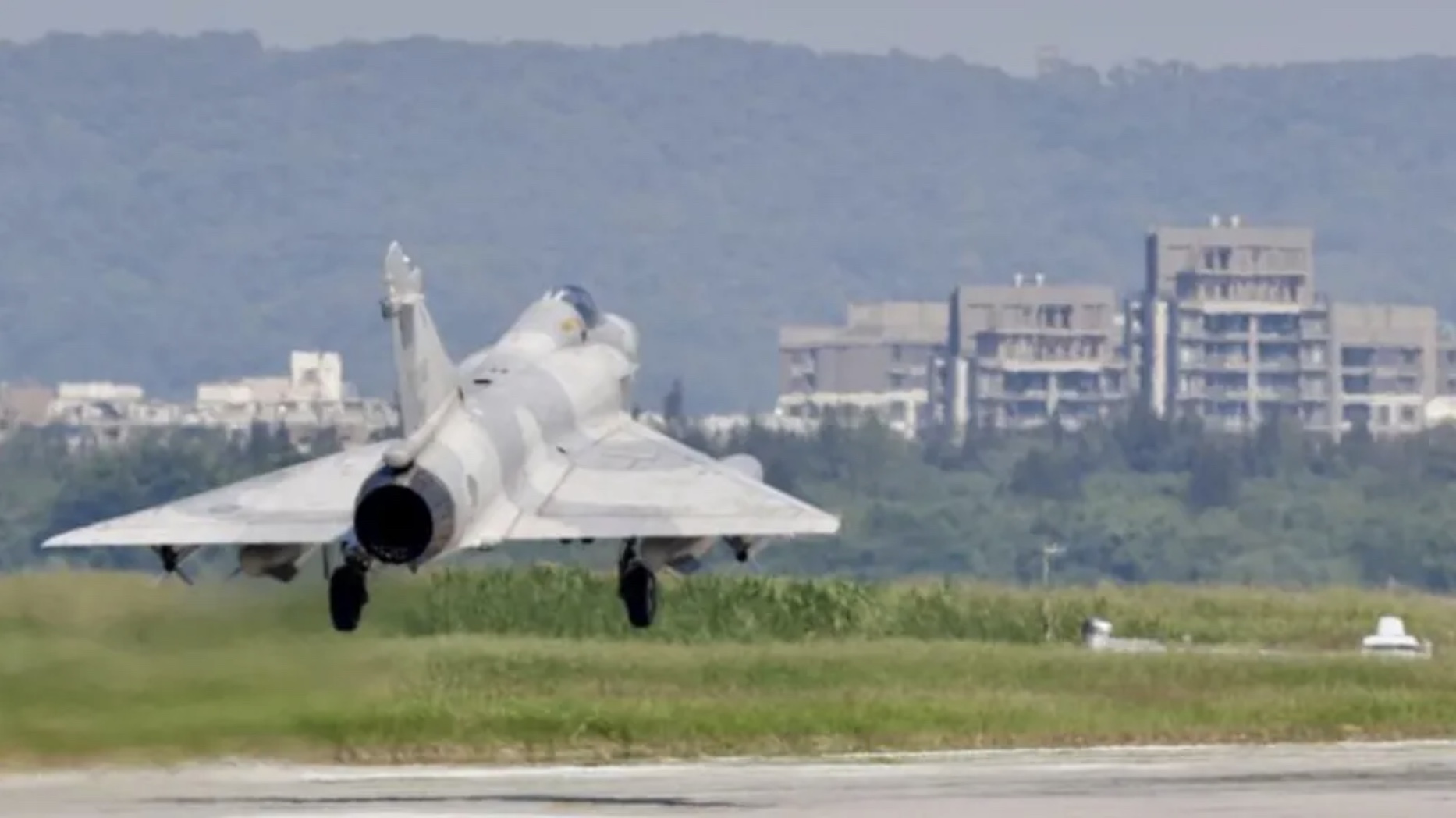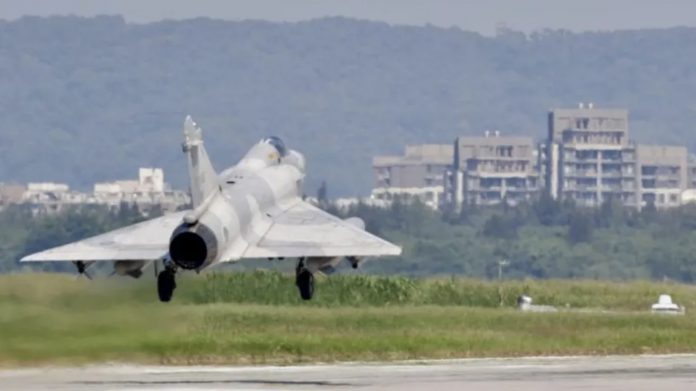เมื่อวันจันทร์ที่ผ่านมา จีนได้เริ่มการซ้อมรบทางทหารครั้งใหม่ใกล้ชายฝั่งของไต้หวัน โดยระบุว่าเป็นการ “ลงโทษ” สำหรับคำปราศรัยของประธานาธิบดี วิลเลียม ไล แห่งไต้หวัน ที่ยืนยันว่าจะ “ต่อต้านการผนวก” หรือ “การล่วงละเมิดอธิปไตยของเรา”
จีนอ้างกรรมสิทธิ์เหนือเกาะไต้หวันซึ่งปกครองตนเอง และประธานาธิบดีสี จิ้นผิง ของจีนได้ให้คำมั่นว่าจะยึดคืนเกาะนี้ด้วยกำลังหากจำเป็น
ทางการไต้หวันรายงานว่าตรวจพบเรือรบ 34 ลำและเครื่องบิน 125 ลำที่จัดขบวนล้อมรอบเกาะเมื่อวันจันทร์ที่ผ่านมา แผนที่ที่เผยแพร่โดยสื่อของรัฐบาลจีนแสดงให้เห็นว่ากองกำลังของจีนประจำการรอบเกาะทั้งหมด และต่อมาได้ระบุว่าการซ้อมรบประสบความสำเร็จเรียบร้อยแล้ว
กองทัพปลดแอกประชาชนจีน (PLA) ระบุว่าการซ้อมรบนี้มีการเข้าร่วมของทุกหน่วยทัพ โดยออกแบบมาเพื่อจำลองการโจมตีไต้หวันทั้งทางบก ทะเล และอากาศ กัปตันหลี่ ซี โฆษกกองบัญชาการยุทธบริเวณภาคตะวันออกของ PLA กล่าวว่าการซ้อมรบครั้งนี้ “ทดสอบความสามารถในการปฏิบัติการร่วมอย่างบูรณาการ” ของกองกำลังทั้งหมด
ขณะที่สนามบินและท่าเรือของไต้หวันยังคงดำเนินการตามปกติ
แถลงการณ์จากกระทรวงกลาโหมไต้หวันก่อนหน้านี้ประณามการเคลื่อนไหวของจีน โดยกล่าวว่าลำดับความสำคัญของไต้หวันคือหลีกเลี่ยงการปะทะโดยตรงที่อาจยกระดับความตึงเครียดไปไกลกว่านี้ เกาะเล็ก ๆ รอบนอกก็ถูกเตรียมพร้อมในระดับสูงสุด
กระทรวงการต่างประเทศของจีนยืนยันว่าการซ้อมรบครั้งนี้ได้จำลองการโจมตีทางทหารและการปิดล้อมท่าเรือ โดยอธิบายว่าความเป็นอิสระของไต้หวัน “ไม่สอดคล้องกับสันติภาพในภูมิภาค”
โพสต์บนบัญชี Weibo ของหน่วยยามฝั่งจีนต่อมาได้แสดงเส้นทางการลาดตระเวนซึ่งมีรูปร่างเป็นรูปหัวใจ
จีนได้จัดการซ้อมรบขนาดใหญ่หลายครั้งใกล้ชายฝั่งไต้หวันตั้งแต่ปี 2022 โดยเครื่องบินรบของจีนมักบินเข้าสู่น่านฟ้าของไต้หวันอย่างสม่ำเสมอ การซ้อมรบครั้งล่าสุดนี้ถูกตั้งชื่อว่า Joint Sword 2024-B และคาดการณ์ไว้ล่วงหน้าตั้งแต่เดือนพฤษภาคมที่ผ่านมา ซึ่งตอนนั้นมีการซ้อมรบในชื่อเดียวกันอย่างเป็นทางการว่าเป็นส่วนที่ A
การซ้อมรบครั้งนั้น ซึ่งจีนอธิบายว่าเป็นการซ้อมรบที่ใหญ่ที่สุดของตน จัดขึ้นพร้อมกับการเข้ารับตำแหน่งของประธานาธิบดีไล ซึ่งปักกิ่งมองว่าเป็น “ผู้ก่อปัญหา” ที่สนับสนุนการแยกตัวเป็นอิสระของไต้หวัน
คำปราศรัยล่าสุดของไลในวันชาติไต้หวันถูกจีนประณาม โดยระบุว่าเขากำลังเพิ่มความตึงเครียดด้วย “เจตนาร้าย”
แม้ว่าการซ้อมรบครั้งนี้จะถูกคาดการณ์ไว้ล่วงหน้า แต่การจัดกำลังและระยะทางที่เรือและเครื่องบินจีนใกล้กับไต้หวัน รวมถึงถ้อยคำที่ใช้ที่รุนแรง ถือเป็นการกระทำที่ก้าวร้าวอย่างยิ่ง
สหรัฐฯ ได้แสดงปฏิกิริยาตอบกลับ โดยกล่าวว่าไม่มีเหตุผลใดที่จีนจะใช้การซ้อมรบครั้งนี้หลังจากคำปราศรัยปกติของไล และจีนควรหลีกเลี่ยงการกระทำใด ๆ ที่อาจเป็นอันตรายต่อสันติภาพและเสถียรภาพในภูมิภาค
ความเป็นมาของการคุกคามทางทหารของจีนต่อไต้หวันเริ่มต้นตั้งแต่ปี 1996 หลังจากไต้หวันจัดการเลือกตั้งประธานาธิบดีโดยตรงครั้งแรก จีนประกาศเขตห้ามบินหลายจุดรอบไต้หวัน และยิงขีปนาวุธพิสัยใกล้ไปยังพื้นที่ทางเหนือและใต้ของไต้หวัน
ในตอนนั้น ประธานาธิบดีบิล คลินตัน ของสหรัฐฯ ได้เคลื่อนกองเรือของกองทัพเรือสหรัฐฯ เข้าสู่ช่องแคบไต้หวันอย่างเงียบ ๆ เพื่อแสดงให้ปักกิ่งเห็นว่าสหรัฐฯ จะป้องกันไม่ให้มีการโจมตีเกาะนี้
ความตึงเครียดลดลงอย่างมากระหว่างปี 2008 ถึง 2016 จนกระทั่งพรรคประชาธิปไตยก้าวหน้า (DPP) ของไต้หวันได้เลือก ไช่ อิงเหวิน เป็นประธานาธิบดี จีนมองว่าพรรค DPP เป็นพรรคที่ยืนหยัดในแนวทางการประกาศเอกราชของไต้หวัน และได้ตอบโต้ด้วยการตัดการติดต่อโดยตรงกับรัฐบาลไทเป
สถานการณ์นี้ยังคงดำเนินต่อไปจนถึงปัจจุบัน
ในเดือนสิงหาคม 2022 แนนซี เปโลซี ประธานสภาผู้แทนราษฎรสหรัฐฯ ได้เดินทางมาเยือนไทเป ซึ่งเป็นครั้งแรกที่ประธานสภาผู้แทนราษฎรสหรัฐฯ ได้เดินทางมายังเกาะนี้ตั้งแต่ปี 1997 การเยือนของเปโลซีและการสนับสนุนอย่างเปิดเผยต่อไต้หวันของเธอ ถูกปักกิ่งมองว่าเป็นการยั่วยุครั้งใหญ่ และใกล้เคียงกับการรับรองรัฐบาลไต้หวันอย่างเป็นทางการโดยนักการเมืองระดับสูงของสหรัฐฯ
จีนได้ตอบโต้ด้วยความโกรธ ด้วยการซ้อมรบ 2 วัน และเป็นครั้งแรกที่ยิงขีปนาวุธข้ามเกาะไต้หวันไปยังมหาสมุทรแปซิฟิก
China ‘punishes’ Taiwan president remarks with new drills

China on Monday launched new military drills off the coast of Taiwan in what it described as “punishment” for a speech given by its president William Lai, when he vowed to “resist annexation” or “encroachment upon our sovereignty”.
China claims the self-governing island of Taiwan as its own and its president Xi Jinping has vowed to retake it by force if necessary.
Taiwan said it detected 34 naval vessels and 125 aircraft in formation around the island on Monday.
Maps published by Chinese state media indicated its forces were positioned around the whole island. It said later that the drills had been successfully concluded.
The Chinese military, known as the People’s Liberation Army (PLA) said the drills involved all wings of the army and were designed to simulate attacking Taiwan by land, sea and air.
Senior Captain Li Xi, spokesperson of the PLA Eastern Theater Command said the drills “fully tested the integrated joint operation capabilities” of its troops.
Taiwan’s airports and ports continued functioning as normal.
An earlier statement from the Taiwanese defence ministry condemned the Chinese move and said its priority was to avoid direct clashes which could escalate the stand-off further. Outlying islands were put on high alert, it added.
China’s foreign ministry confirmed it had simulated military assaults and port blockades, and described Taiwanese independence as being “incompatible” with peace in the region.
A post by the Chinese coast guard on its Weibo account later depicted the route of the patrol in the shape of a heart.
China Coast Guard The China coast guard released an image that showed the formation of patrols around Taiwan were in the shape of a heartChina Coast Guard
China has held several major military drills off the coast of Taiwan since 2022 and its fighter jets regularly enter Taiwanese airspace.
The latest exercise has been dubbed Joint Sword 2024-B by Beijing and had been widely expected since May, when drills bearing the same name and officially labelled as part A were staged.
That exercise, which China described as its largest yet, were timed to coincide with the inauguration of President Lai, who Beijing has long seen as a “troublemaker” advocating for Taiwan’s independence.
His latest comments, made on Taiwan’s national day, were condemned by China, which said he was escalating tensions with “sinister intentions”.
But while these drills were widely expected, the deployment and how close Chinese ships and aircraft were to Taiwan – as well as the fiery rhetoric – could be seen as very aggressive behaviour.
In any other context, it would have been seen as a dramatic escalation – but it came against the backdrop of tensions that were already very high.
The US reacted by saying that there was no justification for the drills after Lai’s “routine” speech, and that China should avoid further actions which may jeopardise peace and stability in the region.
The recent history of China’s military intimidation of Taiwan goes back to 1996, after Taiwan held its first direct presidential elections. China declared several areas around Taiwan off limits, and fired short-range ballistic missiles into those areas off the north and south coasts.
US President Bill Clinton quietly moved US Navy forces into the Taiwan strait to demonstrate to Beijing that the US would prevent an attack on the island.
Tensions eased considerably between 2008 and 2016 – until the leader of Taiwan’s Democratic Progressive Party (DPP) Tsai Ing-wen was elected as president. China considers the DPP to be a hard line pro-independence party, and responded by cutting off all direct contacts with the government in Taipei.
That situation has remained ever since.
In August 2022 US house speaker Nancy Pelosi flew into Taipei – the first time a sitting house speaker had visited the island since 1997. Pelosi’s visit and her open support for Taiwan was seen by Beijing as a huge provocation – coming close to a formal recognition of the government here by a very senior US politician.
It reacted with fury – holding two days of exercises and for the first time ever flying ballistic missiles over the island and in to the Pacific Ocean.
By Rupert Wingfield Hayes and Ayeshea Perera, BBC News

















